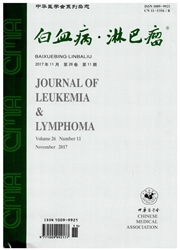

 中文摘要:
中文摘要:
目的进一步提高对系统性肥大细胞增生症(SM)合并克隆性造血系统非肥大细胞疾病(SM-AHNMD)的认识。方法报道1例SM-AHNMD患者临床病理资料,并进行文献复习。结果SM-AHNMD作为SM的第二种常见亚型,主要表现为骨髓或其他皮外器官多病灶致密的肥大细胞浸润,骨髓切片异染色质染色(甲苯胺蓝或吉姆萨)结果阳性,免疫组织化学染色示类胰蛋白酶、CD117、CD25和(或)CD2表达阳性,多数成年患者可发现c—kit基因突变。同时SM—AHNMD表现出非肥大细胞系的其他血液病,如骨髓增生异常综合征、骨髓增殖性肿瘤、急性髓系白血病等的相应临床特征。结论SM—AHNMD除了符合SM的诊断标准外,同时符合非肥大细胞系其他血液病的WHO诊断标准。SM—AHNMD治疗方法以治疗克隆性造血系统非肥大细胞疾病为主,且预后取决于后者,SM治疗则以对症治疗为主。
 英文摘要:
英文摘要:
Objective To improve the understanding of systemic mastocytosis(SM) with associated clonal haematological non-mast-cell lineage disease (SM-AHNMD). Methods The clinical and laboratory features, treatment and prognosis of a rare case of SM-AHNMD was reported and the related literatures were reviewed. Results As the second most common subtype of SM, SM-AHNMD mainly has muhifoeal dense infiltrates of mast cells detected in sections of bone marrow and/or other extracutaneous organs, and some special cytology or biochemical markers(toluidine blue staining, tryptase, CDHT,CD~ and/or CD2) results are positive. C-kit mutations are fonnd in most adult patients. SM-AHNMD also has clinical characters of other clonal haematologica] non-mast-cell lineage disease (HNMD), such as myelodysplastic syndrome, myeloproliferative neoplasms, acute myeloid leukemia. Conclusion SM-AHNMD meets criteria for SM and other HNMD. Treatment for SM-AHNMD is mainly about the therapy of HNMD, and the prognosis greatly depends on the accompanying hematological disorder. There is no special treatment for SM, and the treatment should be directed at symptomatic control.
 同期刊论文项目
同期刊论文项目
 同项目期刊论文
同项目期刊论文
 RAD51 and XRCC3 polymorphisms: Impact on the risk and treatment outcomes of de novo inv(16) or t(16;
RAD51 and XRCC3 polymorphisms: Impact on the risk and treatment outcomes of de novo inv(16) or t(16; Stress hematopoiesis reveals abnormal control of self-renewal, lineage bias, and myeloid differentia
Stress hematopoiesis reveals abnormal control of self-renewal, lineage bias, and myeloid differentia Clinical importance of SF3B1 mutations in Chinese with myelodysplastic syndromes with ring siderobla
Clinical importance of SF3B1 mutations in Chinese with myelodysplastic syndromes with ring siderobla ~JAK2V617F allele burden, JAK2 46/1 haplotype and clinical features of Chinese with myeloproliferati
~JAK2V617F allele burden, JAK2 46/1 haplotype and clinical features of Chinese with myeloproliferati Serum Ferritin Is an Independent Prognostic Factor in Chinese with Myelodysplastic Syndromes Classif
Serum Ferritin Is an Independent Prognostic Factor in Chinese with Myelodysplastic Syndromes Classif Polymorphisms in folate-related genes: impact on risk of adult acute lymphoblastic leukemia rather t
Polymorphisms in folate-related genes: impact on risk of adult acute lymphoblastic leukemia rather t 期刊信息
期刊信息
